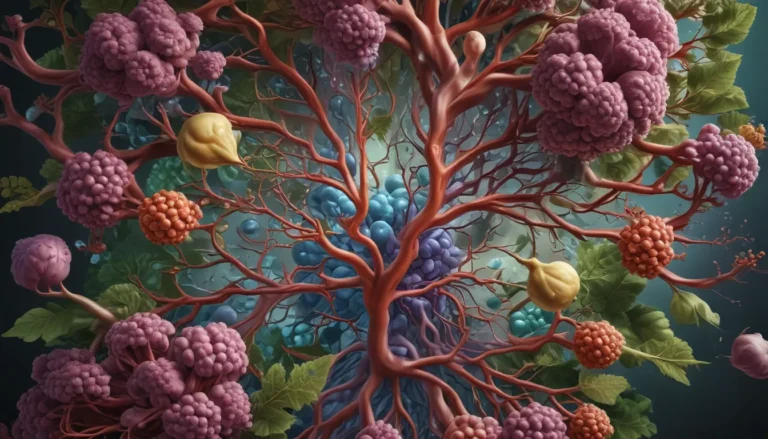A Note About Images: The images used in our articles are for illustration purposes only and may not exactly match the content. They are meant to engage readers, but the text should be relied upon for accurate information.
Cellular communication is the cornerstone of life, facilitating the exchange of information between cells to coordinate activities and respond to external stimuli. While we may be familiar with the basics, the intricacies of this process are truly remarkable. In this article, we will delve into 20 surprising facts about cellular communication that will deepen your appreciation for the remarkable world of cellular interactions. From the role of signaling molecules to the impact on human health, prepare to be amazed by the complexity and ingenuity of cellular communication.
Discovering the Essence of Cellular Communication
Cellular communication is the process by which cells interact with each other, utilizing various signaling molecules like hormones, neurotransmitters, and cytokines to transmit information and coordinate activities. This intricate system allows cells to regulate physiological processes such as metabolism, growth, and immune responses, maintaining homeostasis within the body.
The Diverse Modes of Cellular Communication
- Direct Cell-to-Cell Contact: Specialized structures like gap junctions and synapses enable direct communication and molecule transfer between neighboring cells.
- Long-Distance Signaling: Hormones like insulin and adrenaline travel through the bloodstream to reach target cells, facilitating communication over vast distances.
Delving Deeper into Cellular Communication
Cellular communication plays a pivotal role in the development and functioning of multicellular organisms, allowing cells to work together in forming tissues, organs, and organ systems. Disruptions in cell communication pathways can lead to diseases like cancer, emphasizing the importance of understanding and regulating these intricate mechanisms.
The Classification of Cellular Communication
- Endocrine Signaling: Hormones released into the bloodstream bind to specific receptors on distant target cells, eliciting cellular responses.
- Paracrine Signaling: Signaling molecules act on nearby cells, crucial in immune responses and inflammation.
- Autocrine Signaling: Cells regulate their activities and growth by releasing signaling molecules that act on themselves.
- Synaptic Signaling: Neurons utilize neurotransmitters to communicate through synaptic connections, facilitating electrical impulses in the nervous system.
Nurturing Cellular Communication for Health and Harmony
Cellular communication is essential for maintaining the body’s response to stress, regulating immune system functions, and coordinating growth and development. External factors like drugs and pollutants can influence cell communication, underscoring the need for a balanced and regulated signaling environment within the body.
The Dynamic Nature of Cellular Communication
- Continuous Adjustment: Cells adapt their signaling activities to changing conditions, ensuring equilibrium and proper functioning within the body.
- Disease Implications: Defects in cellular communication pathways can contribute to the development of various diseases, highlighting the importance of maintaining proper signaling mechanisms.
Exploring the Boundless Possibilities of Cellular Communication
Cellular communication extends beyond human cells, with plants and other organisms utilizing signaling to coordinate growth, respond to stimuli, and regulate physiological processes. Medical research has significantly advanced through the study of cellular communication, leading to targeted therapies and potential applications in regenerative medicine.
The Promising Future of Cellular Communication
- Therapeutic Manipulation: Researchers strive to develop treatments that regulate signaling pathways and restore proper communication in diseased cells.
- Regenerative Medicine: Deciphering cell signaling holds the key to promoting tissue repair and regeneration, offering new avenues for medical interventions.
Embracing the Intricacies of Cellular Communication
In conclusion, the world of cellular communication is a fascinating realm that underpins the essential functions of living organisms. From the orchestration of biological processes to the development of innovative therapies, the study of cell signaling pathways continues to unlock new possibilities for human health. As we navigate the complexities of cellular communication, exciting discoveries and advancements await, promising a brighter future through the manipulation and understanding of this intricate process.
FAQs: Unveiling the Mysteries of Cellular Communication
Q: What is cellular communication?
A: Cellular communication refers to the transmission of signals between cells to coordinate activities and responses to stimuli.
Q: How do cells communicate with each other?
A: Cells communicate through chemical signaling using molecules such as hormones, neurotransmitters, and growth factors.
Q: Why is cellular communication important?
A: Cellular communication is crucial for maintaining physiological processes, tissue homeostasis, and overall organism function.
Q: What role does cellular communication play in disease?
A: Disruptions in cellular communication pathways can contribute to disease development, highlighting the need for targeted therapies.
Q: How has cellular communication impacted medicine?
A: Advances in understanding cellular communication have revolutionized medical treatments, particularly in targeted therapies for diseases.
Q: What are the future prospects in the field of cellular communication?
A: Ongoing research and technological advancements offer promising avenues for manipulating cellular communication to enhance human health and well-being.
May your exploration of cellular communication be both enlightening and inspiring, paving the way for a deeper understanding of the intricate mechanisms that govern life at the cellular level. As we continue to unravel the mysteries of cellular communication, let curiosity guide your path towards new discoveries and transformative breakthroughs in the realm of biological interactions.






